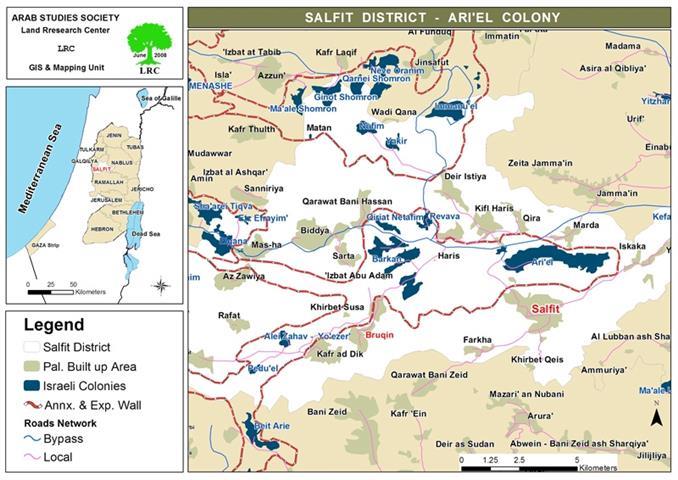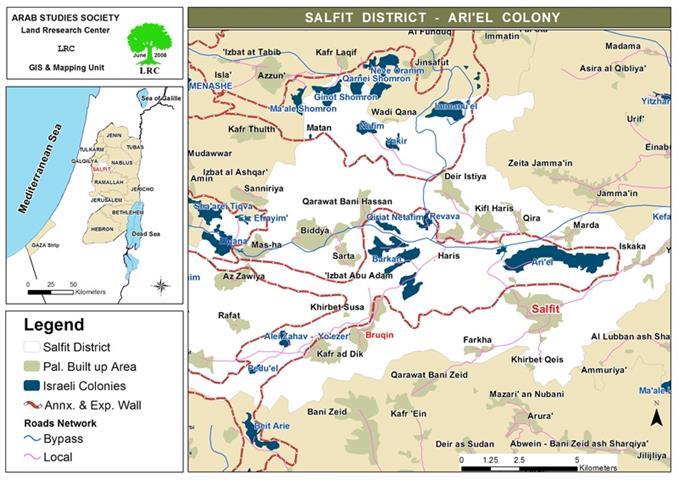The settlement of Ariel is one of the largest Israeli settlements in the occupied West Bank. The settlement, dubbed as the capital of Samaria, was established in 1978 on the eve of the signing of the Camp David Peace Treaty between Egypt and Israel. The initial step in the establishment of the settlement was the confiscation of 500 dunums from the village of Marda and the city of Salfit. Today, the built-up area of the settlement is 20,000 dunums confiscated from the villages of Marda, Kufl Haris, Iskaka in addition to the city of Salfit. See Map 1
During the Netanyahu premiership the settlement was declared as a city that has a college, hotels, housing units as well as factories located in the western side of the settlement. The population of the settlement is currently estimated to be 16,000 according to Israeli official statistics. The municipal boundary of the settlement is 4 times larger than its built-up area which allows it to accommodate additional settlers in the future. In relation to the Palestinians, the settlement is a source of major damage to their lives, their future in addition to their environment due to its big role in spreading diseases in the area.
Photo 1 – A.: An overall view of the settlement of Ariel
The Settlement of Ariel: Source of Pollution of Palestinian Lands and Environment
Most of the houses in the settlement of Ariel are connected with a sewage network through which all of its wastewater is collected. The collected sewage is then dumped into two areas; Ba�aten Al Hammam and Wadi Al Beer both located west the city of Salfit after which it forms a stream that reaches Wadi Burqin on its way to the lands of the village of Kufr Al Deek. Damages to Palestinian agricultural land and environment as well as the spread of diseases have resulted from the dumping process.
Photo 2: The sewage from the settlement of Ariel on its way to the lands of the village of Burqin
The Effects of the Wastewater on Al Matwi Well:
Al Matwi well, located near the city of Salfit, is considered to be a main source of water in the region as it covers 30% of the water needs of the City of Salfit and the villages of Farkha and Khirbet Qais. The water is collected in the well from the water springs scattered on the nearby mountain ridges. Given the fact that the wastewater stream from the settlement of Ariel and the City of Salfit runs only 8 meters away from the well, it has caused its pollution. A number of studies, medical and biological tests have been conducted vis-Ã -vis the well that pointed out a sharp increase in the number of small organisms in the water which negatively affects the health of humans, plants and animals in the region.
Photo 3 & Photo 4: Al Matwi Well, polluted by the wastewater from the settlement of Ariel
The wastewater caused the pollution of the well through the increase of its salt and nitrate contents which made it unfit for agricultural or human consumption. A series of waste waster treatment processes must take place before the water can be usable. The treatment process costs the Salfit Municipality large amounts of money which only adds to its budgetary burdens.
The Effects of Wastewater on Agriculture, Humans and Animals:
The wastewater stemming from the settlement of Ariel and the Salfit Municipality played a large role in the pollution of Salfits� lands through the increase of its sodium-based salts. This has led the lands to become unsuitable for agricultural purposes. It has also caused the death of a large number of plants and trees due to the increase of the concentration of Ammonia in the soil. Moreover, given the fact that some of the wastewater travel over a distance of 40 kilometers, hundreds of dunums are negatively impacted which, in turn, affected the plant distribution and landscape in the area. The region in which Al Matawi well is located was known for its beautiful landscape and breathtaking scenery as well as the large number of water springs it had. The high pollution rate, however, has destroyed that image as people and farmers deserted the land.
Moreover, the wastewater flowing from the settlement of Ariel had had a negative effect on the animal life and diversity in the region; the precipitation of poisonous materials and biological pollutants in the tissues of the animals that drink the polluted water made it possible for diseases to spread up the food chain. Warning against eating the meats of animals grazing near the settlement of Ariel have been expressed which led the residents of nearby communities to purchase their meat and dairy intakes from outside of the Governorate of Salfit. In turn, the meat and dairy industries in Salfit have suffered from an economic depression due to the pollution of its animals. In addition, there has been a marked increase in the number of wild pigs roaming through the region. Such animals have caused great damage to the Palestinian crops as well as their physical well being as a number of pig attacks against Palestinian farmers have been documented in the past.
Photo 5: The Sewage of the Settlement of Ariel Pollutes the Beauty of Arabian Horses
It is worth pointing out that the wastewater stream originated from the settlement of Ariel flow only about 4 meters away from the houses in the village of Burqin while four of the houses are located directly on the way of the stream. The stream also plays a major role in the spread of insects and rodents in the village in which 3800 Palestinians live. An increased number of skin diseases, kidney failures, asthmas as well as cancer cases were reported due to the pollutants present in the wastewater and the bad odor it produces.
Photo 6: the stream of wastewater runs through a
Palestinian built-up area in the village of Burqeen.
Israeli Occupation Prevents Salfit Municipality from Treating the Wastewater:
Israeli occupation forces are continuing to bar Salfit Municipality from building a wastewater treatment plant. The monies required for the building process has been donated by KFW since 1998 and all of the needed plans are ready for implementation. The reason behind the prevention is the insistence of these forces to build a treatment plan that serves both the Governorate of Salfit as well as the settlements of Ariel and Burqan. The Palestinian side has refused the suggestion in 2002 due to the non-legitimacy of both settlements.
Prepared by:
The Land Research Center
LRC






















